| |
|
|
 |
|
| |
|
Ernani Costantini |
|
|
|
|
|
|
| |
|
|
|
|
|
|
|
|
|
|
| |
|
Venice 12/02/1922-23/12/2007 |
|
|
|
|
|
|
| |
|
|
|
|
|
|
|
|
|
|
| |
|
|
|
|
|
|
|
|
|
|
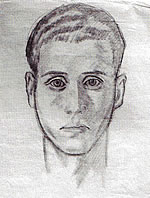 |
| |
| Study for self portrait, 1941, graphite on
paper |
| |
| |
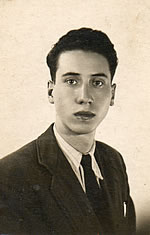 |
| |
| Ernani, October 1942 |
|
|
Ernani Costantini, was born in Venice,
in the working-class area of San Girolamo in Cannaregio, the second
child of a family of modest means. His mother Carolina, known as
Giulia, a housewife, used to work as an embroiderer and impiraressa (bead
stringer) to help make ends meet, while his father Giovanni, known
as Giacomo, was a workman, who had been an invalid since losing a
leg in the First World War.
A few years later the family moved to
a new apartment in the Grimani area, in the Parish of Madonna
dell'Orto. This was the environment where Ermani would spend his
childhood and youth, and as he observed day to day Venetian life,
he became fascinated by the paintings of Tintoretto, Giovanni Bellini
and Cima da Conegliano displayed in the splendid fifteenth century
church.
At the age of eleven, in 1933, having shown both passion
and aptitude for painting, he was sent to the Carmini Institute of
Art, where his teachers included Mario Disertori for life drawing,
Ercole Sibellato for painting, Giorgio Wenter Marini for design and
architectural composition and Giulio Lorenzetti for history of art. |
|
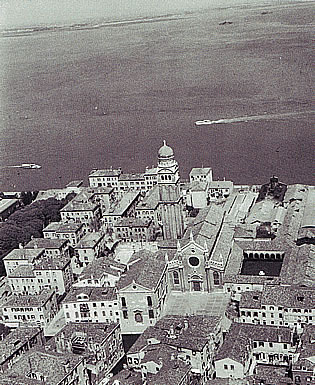 |
| |
|
|
|
|
| View of the Madonna dell'Orto buildings, with the Grimani area to
the left |
 |
 |
 |
 |
 |
|
| |
|
|
|
|
|
|
|
|
|
| |
|
|
|
|
|
|
|
|
|
| |
|
|
|
|
|
|
|
|
|
| |
|
|
|
|
|
|
|
|
|
| |
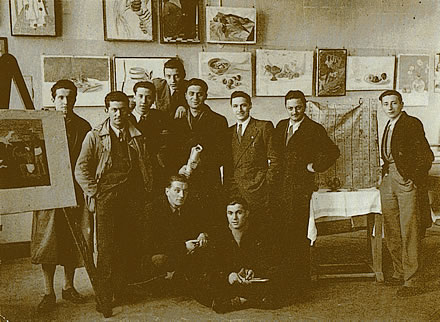 |
|
|
| |
|
|
|
|
|
|
|
|
|
| |
|
Group of students at the Carmini School
(1939).
Ernani is third from left |
|
|
| |
|
|
|
|
|
|
|
|
|
|
| |
|
|
|
|
|
|
|
|
|
|
| |
|
|
|
|
|
|
|
|
|
|
| |
|
|
|
|
|
|
|
|
|
|
 |
 |
 |
 |
 |
 |
 |
 |
 |
 |
 |
| |
|
In 1942, he received his diploma from
the Institute and immediately afterwards he was called up for military
service; he left for Rome in January 1943.
On September 8th 1943, the day that the armistice between Italy
and the Allied forces was declared, he was with his regiment in
Gioia del Colle, Puglia, in Southern Italy. Isolated and without
a commanding officer they were captured by the Germans but managed
to escape. Then he
entered service as a voluntary soldier in a unit destined for the
front in the Italian Campaign and was assigned to the “Legnano” Division
attached to the U.S. Fifth Army.
Between the 7th and the 16th of December 1943 he was
involved in the bloody battle of Monte Lungo in Mignano, near Montecassino.
The following spring he fought in the battle of Garigliano which
led to the liberation of Rome. He continued his military career
in combat units for two years, moving up the Italian peninsula
as far as the Gothic Line, south of
Bologna.
During rare short breaks from combat he drew – using pencil
and paper or pastels which he managed to obtain fortuitously – many
portraits of his fellow allied troops. He would also occasionally
sketch their wives or girlfriends, using the small photographs
that the men carried with them as a guide.
He was eventually promoted to officer and posted to Syracuse in
Sicily.
In December 1945 he was de-mobbed and returned to Venice. |
|
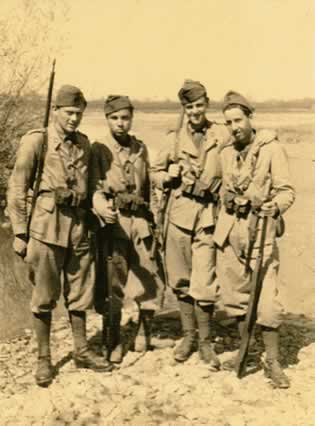 |
| |
|
|
|
|
| Group of soldiers from the Italian
Liberation Corps just before the battle
of Garigliano. Ernani
is the first on the right. |
 |
 |
 |
 |
 |
|
| |
|
|
|
|
|
|
|
|
|
|
| |
|
|
|
|
|
|
|
|
|
|
| |
|
|
|
|
|
|
|
|
|
|
| |
|
|
|
|
|
|
|
|
|
|
 |
 |
 |
 |
 |
 |
 |
 |
 |
 |
 |
| Self portrait, 1949, graphite
on paper |
|
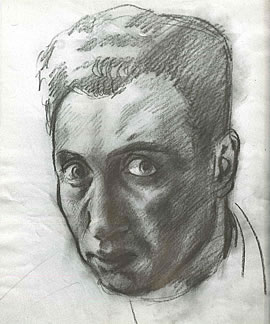 |
|
|
|
|
|
|
| |
|
|
|
|
|
|
|
|
|
|
| |
|
|
|
|
|
|
|
|
|
|
| |
|
From 1946 he held a variety of jobs
out of necessity, including as a scenery painter at the Scalera
Film studio on Giudecca island, where he would meet Lina, and later
as a designer for the Hydrographic Office in Venice.
In 1949 he
was successful in the national recruitment process for art teachers,
and was classified third among applicants from all over Italy.
He began to frequent the studio of Felice Carena. |
|
|
|
|
|
|
| |
|
|
|
|
|
|
|
|
|
|
| |
|
|
|
|
|
|
|
|
|
|
| Lina and Ernani in a gondola on
their wedding day |
|
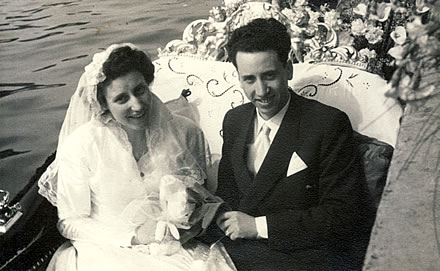 |
|
|
| |
|
|
|
|
|
|
|
|
|
|
| |
|
|
|
|
|
|
|
|
|
|
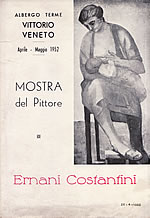 |
| |
| Leaflet from his first solo
exhibition, Vittorio Veneto 1952 |
|
|
In 1950 he married Lina and moved
with her to Vittorio Veneto where he took up his post as a teacher.
In 1952 he gave his first solo exhibition at the Terme Hotel in
Vittorio Veneto. That same year he won the Cassa di Risparmio di
Belluno Prize at the Regional Exhibition.
In 1953 he returned to Venice, having obtained a transfer to a
school closer to home, first in Padua and then in Mestre, and many
years later in Venice itself.
The family, which soon expanded with the arrival of two sons,
Christiano and Giovanni, lived in a small house at San Marziale,
looking out onto the Misericordia canal. Then in 1960 they moved
to an
apartment on the top floor of a tall block in San Canciano, where
his studio was the only room with a view of the spires of Santi Giovanni
e Paolo church. Finally in 1966 the family moved permanently to
San Marcuola, their home once again looking out over the long and
winding Misericordia. |
|
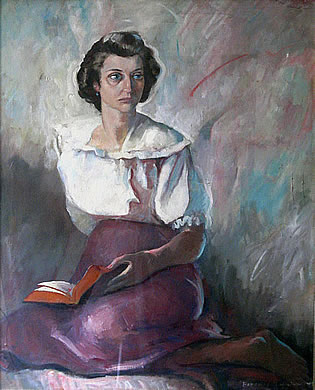 |
| |
|
|
|
|
| Portrait
of Lina, 1950, oil on Masonite |
 |
 |
 |
 |
 |
|
| |
|
|
|
|
|
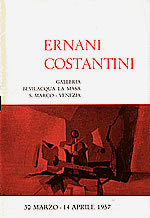 |
| |
| Brochure from the exhibition
at the Bevilacqua La Masa Foundation, 1957 |
|
|
From 1953 Ernani began to exhibit
his works in various locations.
Every year he participated in the
collective exhibition at the Opera Bevilacqua La Masa, where he
would also hold many solo exhibitions. He subsequently took part
in exhibitions, shows and awards in Veneto, throughout Italy and
abroad. He continued to display his works, in almost eighty solo
and numerous collective exhibitions,
all through his life up until his final solo exhibition in November
2007 at the Scuola Grande di San Teodoro hall, Venice. In 1956
he won the Venice City Council award at
the
"Premio Burano";
while in 1958 he won joint first prize at the National Exhibition "Pelizza
da Volpedo", the prize at Vallombrosa for "Mountain
Landscape" and
first prize at "Premio Mestre".
|
|
| |
|
|
|
|
|
|
|
|
|
|
| |
|
|
|
|
|
|
|
|
|
|
| |
|
|
|
|
|
|
|
|
|
|
| |
|
|
|
|
|
|
|
|
|
|
 |
 |
 |
 |
 |
 |
 |
 |
 |
 |
 |
| |
|
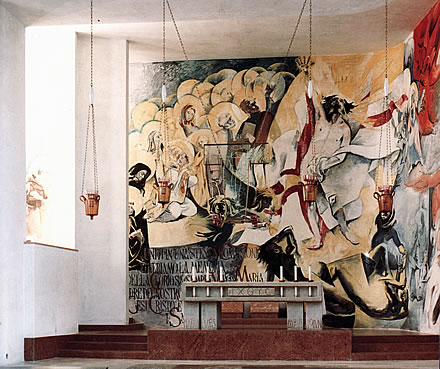 |
|
Partial view of the first large mural in the
church of San Gerardo Sagredo in Venice: Resurrection
of Christ and the Communion of Saints, 1964, oil on wall |
| |
|
|
|
|
|
|
|
|
|
|
| |
|
|
|
|
|
|
|
|
|
|
| |
|
From 1964 onwards he dedicated himself
to working on large decorative cycles of paintings in the churches
of Venice: San Gerardo Sagredo in Sacca Fisola island in
1964, the churches of Cuore Immacolato di Maria at Altobello between
1966 and 1968 and later in 1978; Sant'Agnese at the Cavanis Institute
in Venice in 1968, and other large murals, canvases and mosaics which
he worked on until 2005 and 2006 throughout Venice and the Veneto. |
|
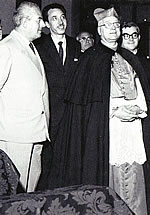 |
|
The Patriarch of Venice Giovanni Urbani inaugurates
the Altobello mural dedicated to San Girolamo Emiliani. From left,
the architect Renato Renosto, architect of the church, and Costantini.
|
| |
|
|
|
|
|
|
|
| |
|
|
|
|
|
|
|
| Ernani on the scaffolding during
work on the mural in the apse of the church in Altobello, Mestre
in 1978. |
|
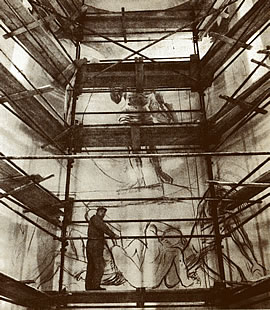 |
|
|
|
| |
|
|
|
|
|
|
|
|
|
|
| |
|
|
|
|
|
|
|
|
|
|
| |
|
|
|
|
|
|
|
|
|
|
| |
|
|
|
|
|
|
|
|
|
|
 |
 |
 |
 |
 |
 |
 |
 |
 |
 |
 |
| |
|
For over thirty years, first as a
host and later as president, he worked for the Venetian Branch
of the UCAI, and was also a member of its national council for over
ten years, dealing with the organisation of important exhibitions,
meetings and debates.
He founded the San Vidal Art Centre, where
monographic and retrospective exhibitions of twentieth century
Venetian and Veneto painting were held and, in 1997, with the support
of Guido Perocco, Pietro Zampetti and Paolo Rizzi organised an
important exhibition "Aspects of
nineteenth century painting in Venice" a collection of works
by the greatest painters of that era. |
|
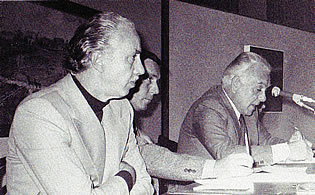 |
| |
|
|
|
|
| Ernani at a round table with Paolo Rizzi and Piero
Zampetti at the San Vidal Art Centre, 1977. |
 |
 |
 |
 |
 |
|
| |
|
|
|
|
|
|
|
|
|
|
| |
|
|
|
|
|
|
|
|
|
|
| |
|
In 1980 he exhibited, in the context
of a vast solo anthology exhibition of around 90 works at the San
Vidal Art Centre in Venice, the cycle of paintings dedicated to
the Song of Songs consisting
of sixteen paintings inspired by verses from the books of
the Bible, of which he also produced a set of three lithographs.
It was the first of a series of pictorial cycles which he would
complete in the following years, as well as canvases on various
subjects and large Religious works in churches.
In 1983 he received an official award from the
Ministry for Tourism and the Performing Arts at Gabicce-mare
and won first prize at the "National
Exhibition of Religious Art – A. Perotti Foundation" in
Venice. In 1984 he won first prize at the "Premio Burano". |
|
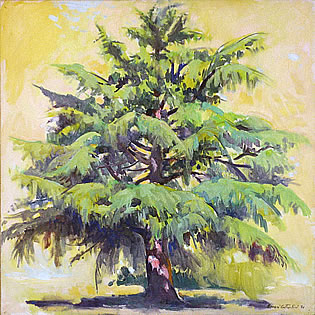 |
| |
|
|
|
|
| Majestic
like Cedars…,
1980, a work from the cycle Song of Songs
|
 |
 |
 |
 |
 |
|
| |
|
|
|
|
|
| |
|
|
|
|
|
| Ernani, winner of the 1984 "Premio
Burano", next to Guido Perocco |
|
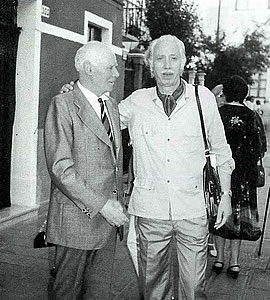 |
|
| |
|
|
|
|
|
|
|
|
|
|
| |
|
|
|
|
|
|
|
|
|
|
| |
|
|
|
|
|
|
|
|
|
|
| |
|
|
|
|
|
|
|
|
|
|
 |
 |
 |
 |
 |
 |
 |
 |
 |
 |
 |
| |
|
Between 1984 and 1985 he embarked upon
a project which he had been considering for years, the painting of
a cycle dedicated to the female characters of the Bible entitled From
Eve to Mary.
This cycle of twelve large canvases was put on
public display for the first time in Venice, from January to February
1987 at the Scuola Grande di San Giovanni Evangelista, accompanied
by a booklet featuring reproductions of the works with some preliminary
sketches, some poems by Antonio Bruni and passages written by Pietro
Nonis, Giorgio Segato, Giorgio Saviane, Luigina Bortolatto, Sergia
Jessi Ferro, and Guido Perocco.
The cycle of paintings was exhibited
again in December of the same year, 1987, in Padua at the Sala
della Gran Guardia, then in March 1988 at the Palazzo della Gran
Guardia, Verona, while in July of that year it was on display at
the renovated Oratorio di Cervarese Santa Croce (Padua). |
|
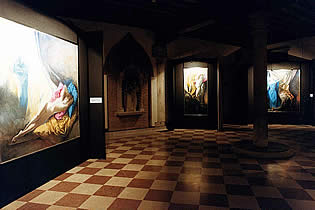 |
| |
|
|
|
|
| A partial view of the first
staging of the exhibition From Eve to
Mary at the Scuola Grande
of San Giovanni Evangelista; Venice 1987 |
 |
 |
 |
 |
 |
|
| |
|
|
|
|
|
|
|
|
|
|
| |
|
|
|
|
|
|
|
|
|
|
| |
|
|
|
|
|
|
|
|
|
|
| |
|
|
|
|
|
|
|
|
|
|
 |
 |
 |
 |
 |
 |
 |
 |
 |
 |
 |
| Presentation
of Mary at the Temple,
1989, Madonna della Salute church, Mestre – Venice |
|
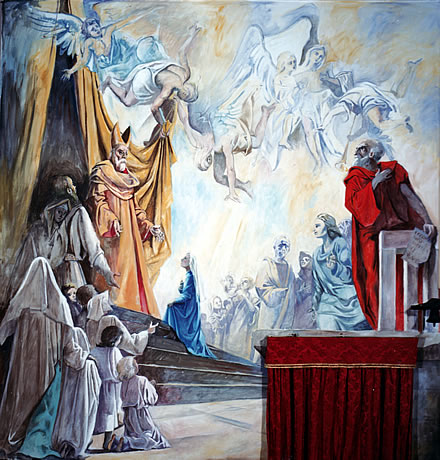 |
|
|
| |
|
|
|
|
|
|
|
|
|
|
| |
|
|
|
|
|
|
|
|
|
|
| |
|
From 1985 to 1986 he began the decoration
of the Church of Madonna della Salute in Mestre which he
would complete between 1989 and 1990.
In September 1988, he exhibited
a cycle of paintings on the theme of Vivere a Venezia (Living
in Venice) at
the Scuola Grande di San Teodoro in Venice, an exceptional
collection of paintings dedicated to Venice life which was the
first in a series of cultural events organised in the city; it
was accompanied by a short pamphlet about the collection featuring
passages by Guido Perocco and Paolo Rizzi.
Ernani exhibited another
important cycle in 1991 at the San Vidal Art Centre: Veneto
Cristiano (Christian Veneto), a cycle
of thirty canvases retracing the places, people and events which
have been influential to the Christian tradition in Veneto. A publication
edited the same year describes the premises, motivations and inspirations
which led to the project with images, preliminary sketches and
reproductions of some of the canvases. |
|
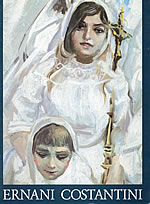 |
|
Front Page of the catalogue Veneto
Cristiano,
1991 |
| |
|
|
|
|
|
|
|
|
|
|
| |
|
|
|
|
|
|
|
|
|
|
| |
|
|
|
|
|
|
|
|
|
|
| |
|
|
|
|
|
|
|
|
|
|
 |
 |
 |
 |
 |
 |
 |
 |
 |
 |
 |
| Ernani in front of the cartoon
for the mosaic of God the Father for the church of Santi
Fabiano e Sebastiano in Padua. |
|
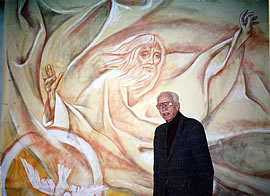 |
|
|
|
|
|
|
| |
|
|
|
|
|
|
|
|
|
|
| |
|
|
|
|
|
|
|
|
|
|
| |
|
December of the previous year saw
the publication of Ernani's paper Arte
Sacra. No [Sacred Art. No], a
reflection on culture and art. In November 1995 a collection of
Ernani's poems L'abbaino [The Garret] was
published.
In 1991 he began work on the decoration of the Church
of Santi Fabiano e Sebastiano in Brusegana, Padua, first with the
interior paintings then in 1994 he started
work on the series of cartoons for the external mosaics. Unfortunately
the mosaics were only partially completed.
Between 1993 and 1996 he painted
the Church of San Michele Arcangelo in Marghera.
In early January
1995, his wife Linda passed away suddenly. |
|
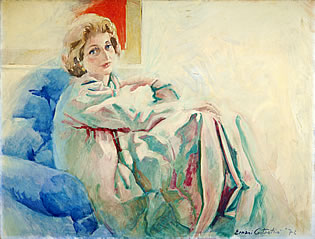 |
| |
|
|
|
|
| Portrait
of Lina, 1972, oil
on canvas |
 |
 |
 |
 |
 |
|
| |
|
|
|
|
|
|
|
|
|
|
| |
|
|
|
|
|
|
|
|
|
|
The Transfiguration
and the Last Supper,
1993, acrylic on wall, Church of San Michele Arcangelo, Marghera,
Venice |
|
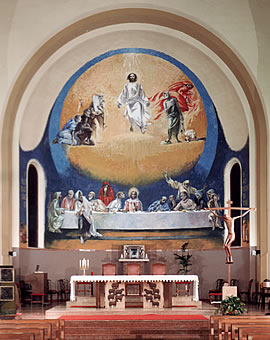 |
|
|
|
|
|
|
| |
|
|
|
|
|
|
|
|
|
|
| |
|
|
|
|
|
|
|
|
|
|
| |
|
|
|
|
|
|
|
|
|
|
| |
|
|
|
|
|
|
|
|
|
|
 |
 |
 |
 |
 |
 |
 |
 |
 |
 |
 |
| |
|
In October 1996 the charm of Venice
was once again on display in his solo exhibition Diario
veneziano [A Venetian Diary] at the San Vidal Art Centre, with panoramas, situations,
memories and emotions, as if in a kind of personal diary illustrated
in an original way through paintings which reflected the artist's
vast cultural knowledge. |
|
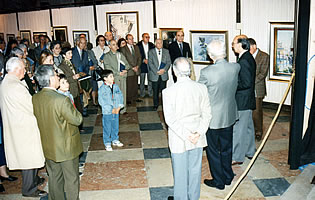 |
| |
|
|
|
|
| Inauguration of the exhibition
Diario Veneziano [Venetian Diary] |
 |
 |
 |
 |
 |
|
| |
|
|
|
|
|
| |
|
|
|
|
|
| Resurrection, 1997, oil
on canvas, Church of the Resurrection, Marghera, Venice |
|
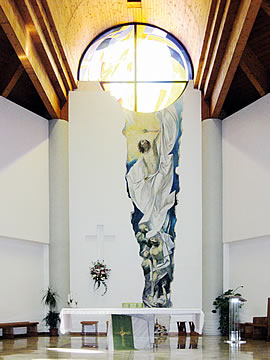 |
|
| |
|
|
|
|
|
|
|
|
|
|
| |
|
|
|
|
|
|
|
|
|
|
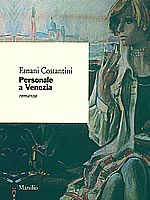 |
| |
| Personale a Venezia [Solo
Exhibition in Venice], 1999, Marsilio, Venice |
|
|
In 1997 he painted for the Church
of the Resurrection in Marghera and in 1998 for the Church of Santa
Barbara at Gazzera.
In those years Costantini also consolidated
his artistic output as a writer.
In 1999 Ernani had his first novel published: Personale a Venezia
[Solo Exhibition in Venice]. May 2001 saw the release of his
second novel: Quella lontana estate del ’45 [That
far off summer of ’45]. In May of the following year,
2002, came his third novel: Ritorno a Monte Lungo [Return to
Monte Lungo]. |
|
|
|
|
|
|
| |
|
|
|
|
|
|
|
|
|
| |
|
|
|
|
|
|
|
|
|
| |
|
|
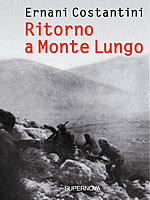 |
|
Ritorno a Montelungo [Return
to Monte Lungo], 2002, Supernova, Venice |
|
|
| |
|
|
|
|
|
|
|
|
|
|
| |
|
|
|
|
|
|
|
|
|
|
| |
|
|
|
|
|
|
|
|
|
|
| |
|
|
|
|
|
|
|
|
|
|
 |
 |
 |
 |
 |
 |
 |
 |
 |
 |
 |
| |
|
In May 2002 a vast 'Anthology
Exhibition' was held in the Sant'Apollonia Hall in
the Diocesan Museum at St. Mark's, Venice.
Ernani had turned eighty.
His art had over time achieved a technical and expressive maturity
demonstrated on this occasion in the fiftieth year of his artistic
career.
That same year he received an award in recognition of his
career from the Mayor of Venice. |
|
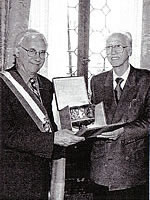 |
|
The Mayor of Venice Paolo Costa presents Ernani
with the Barovier Cup, 2002 |
| |
|
|
|
|
|
|
|
|
|
|
| |
|
|
|
|
|
|
|
|
|
|
| |
|
|
|
|
|
|
|
|
|
|
| |
|
|
|
|
|
|
|
|
|
|
 |
 |
 |
 |
 |
 |
 |
 |
 |
 |
 |
| Pious Women
at the Sepulchre,
2005, sgraffito, Church of the Resurrection, Marghera, Venice |
|
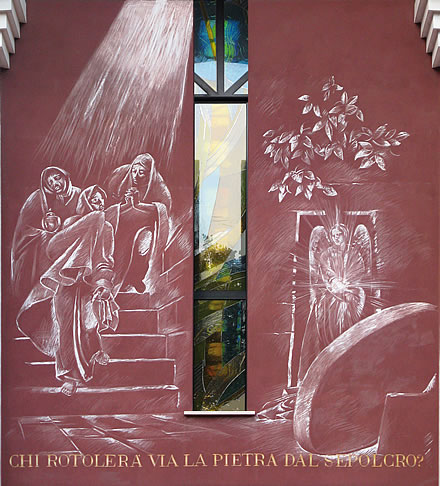 |
|
|
| |
|
|
|
|
|
|
|
|
|
|
| |
|
|
|
|
|
|
|
|
|
|
| |
|
In 2005, at the age of 83, he climbed
up the scaffolding one last time to complete his sgraffito Pious
Women at the Sepulchre above the door of the church of the
Resurrection in Marghera.
In November 2005 Ernani's fourth and
final novel was published: Sst… è la
luna, [Ssh… it's the moon].
In November 2007 Ernani
prepared a new anthological solo exhibition at the Scuola Grande
di San Teodoro, which featured works which had been displayed previously
together with his later works completed between 2002 and 2006.
Ernani Costantini was not able to attend the exhibition; the serious
illness which had afflicted him for the previous two years made
it impossible.
He died on December 23rd. The religious funeral
ceremony was held in his beloved Church of the Madonna dell'Orto,
which was full and the ceremony was jointly conducted by six priests,
friends and parish priests of the churches which housed his works.
Among the great works of Tintoretto which inspired him as a child,
he was accompanied on his final journey by prayers.
"… Oh Lord
thou pluckest me out … ", was
the final citation which concluded with the words Ssh…
it's the moon. |
|
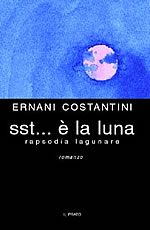 |
|
Sst… è la luna, rapsodia lagunare [Ssh… it's
the moon, Lagoon Rhapsody], Il Prato, Padua, 2005 |
| |
|
|
|
|
|
|
|
|
|
|
| |
|
|
|
|
|
|
|
|
|
|
| Ernani Costantini |
| (ph. F. Barasciutti ©) |
|
|
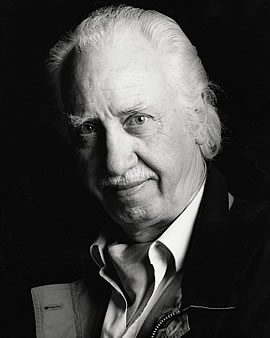 |
|
|
|
|
|
|
| |
|
|
|
|
|
|
|
|
|
|
| |
|
|
|
|
|
|
|
|
|
|
| |
|
|
|
|
|
|
|
|
|
|
| |
|
|
|
|
|
|
|
|
|
|
 |
 |
 |
 |
 |
 |
 |
 |
 |
 |
 |
|

